Shop our historical maps
News
No SVT, the tradition of the Lucia procession was not invented by the founders of Skansen
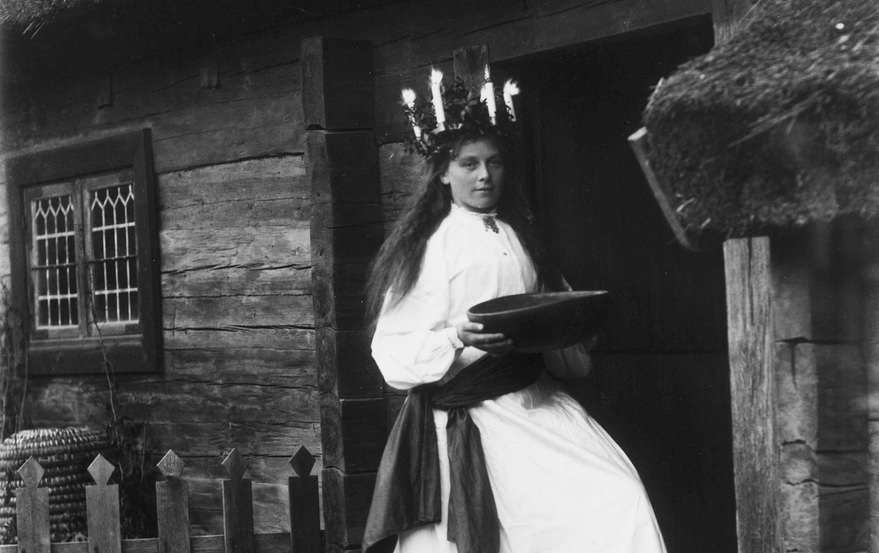
Sep
Lucia, with candles in her hair and her singing entourage, has long brightened the winter darkness in Sweden. But is the tradition of Lucia processions actually invented by the founders of Skansen in 1893? Allmogens fact checker an article in SVT.
Claim:
For me it was quite comical to realise that Artur Hazelius, the founder of the Nordic Museum and Skansen, decided to draw some people, so he invented the Lucia train. People might think it's some ancient Swedish tradition. But it was Artur Hazelius who sat in his room and concocted the idea.
Conclusion:
Pure and simple falsification of history.
Summary:
For SVT's readers, author Elisabeth Åsbrink gives the very concise picture that the Lucia tradition of the white-clad bride with her luciakrona and his entourage is a completely new invention.
This is, of course, a completely absurd statement. I thought something must have gone crazy here, that it was just a clumsy statement.
So I dug further into her recently published book The words that shaped Sweden, in which Åsbrink tackles "Swedishness" through personal essays on words that have helped shape the image of Sweden in various ways. In it, she writes that "Lucia processions with starlets and Staffan songs in December" were "new inventions drawn from the imagination of Artur Hazelius."

He invented games and traditions and gave the past a life it never had.
Elisabeth Åsbrink, The Words that Shaped Sweden (2018)
So we get a little more meat on our bones. So is it true that Hazelius dreamt up the modern St Lucia procession and "invented" all the games and traditions, some of which still exist today at Skansen? No, as we shall see, there is absolutely no evidence for it. It seems to be a statement drawn entirely from Elisabeth Åsbrink's imagination, or else it is based on serious misunderstandings of the history of our traditions.
But first let's look at Skansen as a phenomenon. The Open Air Museum Skansen was founded in 1891 by the folklorist Arthur Hazelius (1833-1901), who also founded Nordic Museum 1873. "Know thyself" was Hazelius' motto, and for him the meaning of the words was that only by knowing one's own history is it possible to truly know oneself.
The purpose of Skansen was to preserve the old Swedish farming society that Hazelius saw was disappearing with the industrialisation and urbanisation of Sweden, and to show at Skansen how people lived in different parts of Sweden. Or as the Nordic Museum itself describes its mission in its yearbook Fataburen 1904:
The great and important task of the castle, to awaken and maintain the feeling for the fatherland and its memories through patriotic celebrations and the revival of old customs among our people, has been sought to be fulfilled during the years 1904 and 1905 as always.
To fulfil this task, knowledge of old local traditions from Sweden's many regions was gathered and this diversity of traditions was brought to Skansen. This helped not only to preserve the knowledge but also to popularise some of the traditions. New Year's Eve, Epiphany, Easter, Pentecost, Walpurgis Eve, Spring Festival, Midsummer, Bellman's Day, Lucia, Christmas Market, and many smaller events in between.
There is no doubt that the traditions of Lucia and stargazers go back much further than Skansen and Arthur Hazelius himself. It is well documented in older sources. A summary comes here:
Lucia - Lussebrud
The Lucia tradition is as I have written about before both traditional and modern, both old and new at the same time. The folklore surrounding Lussenatten and the "Lussefärs family" has very old, ancient origins that can be linked to the winter solstice and the longest and darkest night of the year, modernatten.

National Museum
The first known documentation of something similar to our brightly adorned Lucia in white robes, however, is from Västergötland in 1764, a travelogue by the Scanian priest C F Nyman from his visit to Horn north of Skövde, and is thus a relatively late story - although theories have also been put forward that there are links to an older, pagan goddess of light and the various brides who appeared in the old folktron annual festivals and fertility rites right into our time (e.g.. May bride / spring bride and midsummer bride).
This latter element of the Christmas tradition originated in western Sweden around Lake Vänern; Västergötland, Värmland, Dalsland and Bohuslän. Lusse was also celebrated in eastern Sweden, in Småland, Östergötland, Södermanland, Närke, Västmanland and south-western Dalarna. In Jämtland, the Lusse bride was still present in the mid-19th century. But in other parts of the country, the tradition was relatively unknown before the 20th century.
The performance of the Lusse bride was not infrequently staged as a regular wedding procession, she was accompanied by her bridesmaids, and preceded by two flower bearers, especially in those cases where her performance was not confined to her own home. - A striking feature of Bohuslandic village custom (Lane-Ryr), namely that a girl with illegitimate children was preferred for the Lusse-bride, is also more in keeping with the beliefs and customs of the annual festival-brides than with Saint Lucia - Sometimes Lucia or the Lusse-bride was accompanied by her husband, who was called the Lusse-groom or the Lusse-bridegroom. (Småland, Östergötland, Dalsland)
Hilding Celander, Nordic Christmas (1928)
The Swedish Lucia procession of our time is a mixture of our own ancient paganism, our Catholic Middle Ages and our present day. A unique Swedish tradition, pure and simple.
The Star Giants
The tradition of the stargazer has its origins in the Christian Christmas plays held on Epiphany, Epiphany, which is one of the oldest Christian feasts known to us. It has been celebrated since the centuries after the birth of Jesus. In Sweden, Christmas carols have been played for many hundreds of years.
But it wasn't just at the Christmas games on Epiphany Day that starlets could be seen. Celander writes in his book The Star Giants (1950) that the stargazers in the Vänerlandskapen and in Stockholm "have previously begun their wandering already on Christmas Day - as 'lussegossar'."
Star Giants on Lucia Day, that is, called lussegossar. Knowing that, it suddenly doesn't seem far-fetched that they too would one day be part of the Lucia procession.

However, in many Swedish villages there are still those who, among their memories of childhood Christmas, count the appearance of the stargazers as the most festive moment of Christmas.
Hilding Celander, Nordic Christmas (1928)
In Hilding Celander's book Nordic Christmas (1928) tells of the costumed procession from farm to farm, a much appreciated feature of popular Christmas celebrations, and this "Christmas masquerade" reached its peak on Epiphany Eve and Epiphany Day.
In Skåne it was said that go Christmas shopping. In Sätesdalen went small basin, in other places Christmas goats were wandering around and in many different places in the Nordic countries, writes Celander, such as Hardanger in Norway, Dalsland in Sweden and Dagö in Estonia, people talked about julageiter or thirteen-digit budget. On Julö in Estonia there is talk of the Christmas goose who go around scaring children. But the big event of the thirteenth day was still The Star Giants, symbolising the three wise men and the star that appeared at the birth of Jesus.
Staffan's kids
The lads singing "Staffan was a stallion" has its origins in another tradition that took place on Boxing Day, Staffan's Day, which is celebrated in memory of Saint Stephen in the Catholic Church. The Annunciation was above all a horses day according to Celander, and the custom of races was given in the vernacular the name Staffan's stage or Staffansritt. Celander also provides clues to the ancient origins of the custom:
stage is the same word, with which already the Ancient literature described the horse games, skeidwhich the ancients of the North indulged in with such passion.
Hilding Celander, Nordic Christmas (1928)
The New Year's Day started just like on Christmas morning with a hearty meal. "In many Swedish villages," Celander says, "the first meal on New Year's Day was both particularly early and particularly heavy. "In Västergötland, the meal was even called "lilla lusse", but on New Year's Day it was not Lucia who carried the food into the bedroom for the farm folk, but the head of the household or the matron herself.
The Staffan song has been sung by star gazers, or Staffan's gazers, since the Middle Ages and is one of our oldest songs. "No song has been so well known and loved by the Swedish people", according to Celander. The two traditions of the stjärngossar and the staffansgossar seem to have influenced each other more and more, which became evident at the latest in the 19th century when the stjärngossar sang the Staffansvisan and the staffansgossar on the other hand took up influences from the stjärngossespelen as elements in the Relay rides on Boxing Day.
Traditions of the Skansen
Skansen took up the tradition of the star cats in 1893, and even then you can see that it has completely merged with the tradition of the Year's Day star cats. I dug into the Nordic Museum's own reports on the operation of Skansen between 1904 and 1935, the yearbook Fataburen, which are digitised by Project Runeberg.
In 1908, the stargazers sang in and around the cottages traditionally from the beginning of the year until the thirteenth day of the traditional Christmas games, and also from Boxing Day according to the old tradition of Staffan's stage.

In the activity reports, it is clear that the Lucia tradition and the star gazers are anything but a figment of Hazelius' imagination, but existed as two completely separate traditions at Skansen long after his death. In the section on Skansen's annual celebrations, we can see from a number of years how Christmas celebrations looked at Skansen:

On New Year's Day 1912, Lucia appeared in the High Loft, while stargazers wandered around Skansen singing Christmas carols.

At the 1912 Christmas market, there is no mention of Lucia, but there is a performance of the Christmas goat from Värmland and "little busy Santas".

In 1916, Lucia offered "refreshments" in the High Loft and Bollnäs Cottage, but without star gazers.

In 1925, the Lucia celebration on 13 December consisted of the usual Lucia with bridesmaids but also boys dressed as "lusse-gubbars", according to a local tradition from Dalby parish in Värmland. From Boxing Day onwards, 10 star boys sang during the holidays in the Skansen cottages.

In 1927, Lucia and four bridesmaids sang in the various cottages of the Skansen on 13 December, while the songs of the star gazers had to wait until after the New Year. The same arrangement applied in 1926. 1927 was also the last year in which the star gazers were mentioned as a separate tradition in the Skansen's annual report. The following years only Lucia and her four bridesmaids are mentioned.
So here we can see two separate traditions, Lucia and the Star Giants, celebrated separately year after year at least until 1927, 26 years after Arthur Hazelius' death. Both traditions, and all the other games and traditions that took place at Skansen, are firmly rooted in the traditions of the old farming community from Sweden's many regions. That Hazelius would have felt compelled to "dream up" a whole new Lucia procession without any basis in either tradition just to "draw people" to Skansen is, I think, unlikely. It's actually quite cheeky to diminish Hazelius' work in that way.
However, there is no doubt that at some point in the early 20th century, the sparklers were incorporated as part of the Lucia processions around Sweden, followed later by Santas and gingerbread. Perhaps it may even have occurred at Skansen some year without it appearing in their own sources, who knows. But rather than trying to explain away the whole old tradition of Lucia processions as something taken from a single person's imagination, as Åsbrink does, it is more truthful to see today's Lucia processions as a natural development of a much-loved, old tradition that has quite naturally changed over time and been added to by new generations.
More likely, the modernisation of the Lucia tradition, with its entourage of bridesmaids, star gooses, gingerbread men and elves, really took off with the enormous breakthrough that Lucia got in 1927 when Stockholms Dagblad announced the first Lucia competition and organised the first Lucia procession in the form of a procession through Stockholm. Before long, several of the country's newspapers followed suit and organised their own Lucia processions around the country. The Lucia trains were commercialised. It was also only the following year, 1928, that the very familiar carol The night goes heavy feather was printed in the book Songs for school.
Analysis
The SVT interview with the "clumsy" statement comes after Elisabeth Åsbrink launched her book The words that shaped Sweden, in which she focuses on words that she believes have contributed in different ways to shaping the image of Sweden, Swedishness and Swedish values. By breaking down the words, and the history behind the words, she tries to reason about what Swedishness has meant throughout history and show that what we see as typically Swedish today may in fact not be so Swedish - and find Swedishness where we may not think of it.
Åsbrink is a writer and journalist who has worked for many years at SVT, and is a frequent writer, reviewer and columnist for Dagens Nyheter. She also writes for the magazine VI, Judisk Krönika, the Danish magazine Weekend-Avisen, and others. A driving force behind the book The words that shaped Sweden is, according to Åsbrink herself, her immigrant background. She was born in Sweden to a Hungarian father and British mother, which has led her to reflect a lot on Swedishness and her own sense of alienation during her childhood years. The book opens with the following quote, which I think says a lot about the purpose of the book:
A nation is a group of people united by a common misunderstanding of their origins and a dislike for their neighbours.
Swedish history, Swedish culture, the Swedish nation is a "common misconception" that Åsbrink wants to correct in some small way with his book. "Language is power," she writes. Whoever has the power over language and words also has the power to create, shape and break down identities - like the Swedish one.
This also seems to be Åsbrink's ambition, to contribute to loosen up what some in the radical, norm-critical ideological milieu believe is an "exclusive Swedishness" based on a shared origin in Sweden and the common culture that has developed here over millennia.

Aftonbladet's Carsten Palmær says that Åsbrink's depiction of Sweden's political history is "thin and typical of the times" with a predominant focus on the authorities, state power and minorities such as Jews and Sami.
"Among the hundreds of people who have shaped Elisabeth Åsbrink's Sweden," Palmær writes, "there is not a single farmer and not a single manual worker. Power does not emanate from the people, but from authoritative and hardy social engineers: Gustav Vasa, Axel Oxenstierna, Per Albin Hansson and Tage Erlander." In other words, the exact opposite of the story our dear Vilhelm Moberg told in his books, allmogens history,

Also SvD's Håkan Lindgren have read the book. Even he finds factual errors. But above all, he objects to the overly strident rejection of all forms of nationalism. He says that it is "extremely Swedish to regard nationalism as dirt"
Looking at Åsbrink's other achievements and commitments, one could categorise Åsbrink as one of many radically anti-national writers and authors, in the sense that all degrees of nationalism are considered evil. Another author who falls into this category is, for example new director of the History Museum, Katherine Hauptman, who contributed to the book Disrupting homogeneity. That book argues that cultural heritage and history are "among the most powerful policy tools available", and that these tools should use of the "good guys".
These people see it as legitimate to use history and our cultural heritage to counter what they see as "dark forces" - even if it means that our cultural heritage actually suffers and that the rest of us who not has party political ambitions be removed the chance to "know ourselves" by getting a true picture of our history. A huge violation. They share this view of the role of cultural heritage in building society with the Sweden Democrats.
The Sweden Democrats, on the other hand, have a view of Swedish culture that, although more truthful and based on archaeological and cultural-historical facts, is based on the Swedish central power in Stockholm. In doing so, they turn a blind eye, in my opinion, to much of the original regional diversity of cultures that existed in the many provinces during the emergence of Sweden. Many more original, more local cultures have been incorporated and merged into the Swedish one, and that must not be forgotten. Then we are missing out.
I'm Swedish, but I'm also a repentant, and many of the Swedish traditions we celebrate today often have a stronger connection to the local and regional than to the capital. Traditions definitely differed from region to region and often even from one parish to another. All this cultural diversity, after many thousands of years of history, has resulted in what we see today as Swedish culture - a culture that many argue does not exist, or that it is so "homogeneous" and "boring", or that it needs to be "enriched" with "diversity". If only they knew what diversity they would find if they dug where they stood on the Swedish soil!
Where it becomes problematic with the anti-national left-liberal and to some extent left-extremist thinking, which permeates the Swedish cultural sector and large parts of the journalistic profession, is that they see a long-established cultural community among the Swedish majority population as something evil that can benefit the "enemy", i.e. the Sweden Democrats. They have the same contemptuous view of all degrees of nationalism, even though the history of nationalism shows that in many cases it has defended the very values that left-liberals claim to stand for - freedom of the individual, of the word and of thought. The freedom of democracy.
A political party, the Sweden Democrats, has been given exclusive rights to our cultural heritage, our history, our nation. But our culture is something all people and parties in Sweden must relate to. This has become quite clear in recent years when all the party leaders have entered the debate about our "Swedish values" in a daze. Even I as a libertarian, a libertarian anarchist who sees red as soon as politicians come into the picture, have to relate to our Swedish democracy and the culture I was born into. I think you do yourself a great disservice when you mutilate yourself, cut off your roots, deny your culture, just because it might otherwise "benefit SD".
It is also here, somewhere in Åsbrink's desire to give a boot to the Sweden Democrats' big Swedish nationalism, that she loses her way and loses her credibility. Looking at Åsbrink's other commitments, the picture of an underlying political agenda becomes even clearer. Another book Åsbrink has contributed to is The dangerous diversity: on the worldview of the Sweden Democratspublished in 2017 by the left-wing think tank Arena Idé, which receives its funding from trade unions such as LO, Saco and TCO.
Åsbrink was also one of 20 "famous profiles" behind the #vimåsteprata initiative launched earlier this year "in defence of democracy", as democracy is allegedly "threatened" by more and more voters losing confidence in incompetent politicians and therefore voting "wrong". The profiles see what they say are "worrying parallels with the past" because people get so angry when incompetent politicians mess up - and anger can never be justified. Right?
One result of the initiative is the book Handbook for Democrats which Åsbrink wrote together with Sverker Sörlin and Ola Larsmo, also a freelance writer for Dagens Nyheter, who together with Henrik Arnstad makes the historical podcast A Swedish tiger.
Åsbrink is described by left-wing extremist "whiteness scholar" Tobias Hubinette as "an ardent anti-racist and anti-fascist" and a "celebrated and radical anti-Nazi", while at the same time he earlier this year accused her of lying "both brazenly and uninhibitedly" that it was she who revealed that Ingvar Kamprad had been a "Lindholm Nazi", when in fact it was the author Thomas Sjöberg who published and wrote about it in his 1998 book "Ingvar Kamprad and his IKEA".
In conclusion, Elisabeth Åsbrink seems to be anything but an "ordinary" writer who happens to be interested in Swedish history. So is there anything right in what Åsbrink writes in her book? Yes. Language is power.
Subscribe to YouTube:
If you appreciate Allmogens independent work to portray our fine Swedish history and Nordic culture, you are welcome to buy something nice in the shop or support us with a voluntary donation. Thank you in advance!
Support Allmogens via Swish: 123 258 97 29
Support Allmogens by becoming a member
Support Allmogens in your will
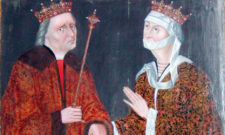
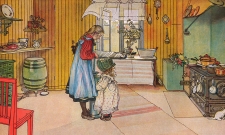



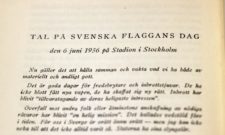


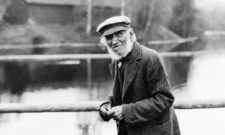
Another book that will become compulsory reading in schools? Thanks for your excellent post!
Damn, you link wrong Sataffan🙄 https://sv.m.wikipedia.org/wiki/Staffan_stalledräng
Thank you for a necessary and informative article! The lackeys of the globalists are working incessantly to try to smash Swedish culture and the memories of the common people, in order to more easily impose an international Marxism where everyone serves a small exclusive elite. Allmogen.se is the counterforce we all need to not forget our heritage.
That a woman of Hungarian and English descent has problems with her own identity is understandable, but should not be passed on to those of us who cherish the Swedish language.
According to Bock Saga, Lucia has to do with the girl's maturation into a woman. Lucia is an enlightening dream for the young girl, telling her that the time has come and longing is rising like the sap in her body. If the old woman in the village also believes that the young woman is ready for a man, the time of Lucia becomes the beginning of a process that ends on Midsummer night, on a bed made of flowers, in the village meadow. There, man and woman are united for the first time, in the time of flowers... the time of fertility...
All our oldest pagan traditions have been transformed to suit the Catholic Church, or removed.
I myself am of the opinion that the pagan traditions were for the good of the people, while the church's are for the enrichment of the elite, at the expense of the common man. Today we also have what is called democracy, where the only difference is that the political elite, in symbiosis with the banking elite, share the spoils, the work of the common man. Moberg wrote about this quite clearly during his lifetime, for everyone to easily understand. And in a FB post, I dared to try to reproduce my own interpretation of him:
Wilhelm Moberg is perhaps Sweden's greatest fighter of all time for people's freedom to think, write and express what they want. The personal freedom to live and develop according to one's own mind, and not to obey the lords of the state, was central to him. Perhaps it could be argued that he was the anarchist of his time, in the positive sense.
Moberg realised early on that the banks' debt system only serves to enrich the already rich, at the expense of the ambitious.
The state, the servants of the people, thus became the lackeys of the banks and a corrupt system could emerge. In return for privileges, the privately owned banks were allowed to print and lend money to the people at interest. This system has been in place in Sweden since at least the 16th century, and to this day the common people have not understood that they are the losers, and that the bankers are the parasites of the people. And every four years the people run to the polls and think it makes a difference.
Moberg was historically oriented and could show how power, in various guises over 1000 years, has always sought to wrest from the common people their hard-earned bread, to fill the vaults of the bankers. Or to the wars.
Wilhelm Moberg grew up in the stony, barren soil of Småland and was shaped by it into a sensitive, reflective and freedom-loving person. His literary works and struggle for human freedom were not for his own sake, but for the sake of the already dead, who outnumber us infinitely, and for the sake of all unborn children in the future. They are our people, and they are many, and they all live through us. It is this legacy we must cherish, the people's struggle for freedom.
Moberg should be one of our greatest role models as we defend the legacy of our ancestors at the very last moment, and fight for the survival of our people. Ride Tonight!
Wilhelm Moberg identified Nazism as a threat to freedom, and Rid I Natt is based on the idea that Sweden is being invaded by Nazis against whom we are resisting. Today I think Moberg would have understood the present, that it is the Jewish power elite and its octopus-like banking system that is not only the greatest threat to our country and people, but the greatest threat to all peoples and the entire planet.
When Wilhelm Moberg went into the water one evening in the 1970s in search of endless sleep, I don't think it was just because of writer's cramp.
He writes: "It is twenty past seven. I go to search the lake, sleep without end. Forgive me, I could not endure."
What did he not endure?